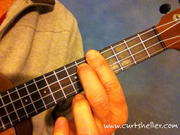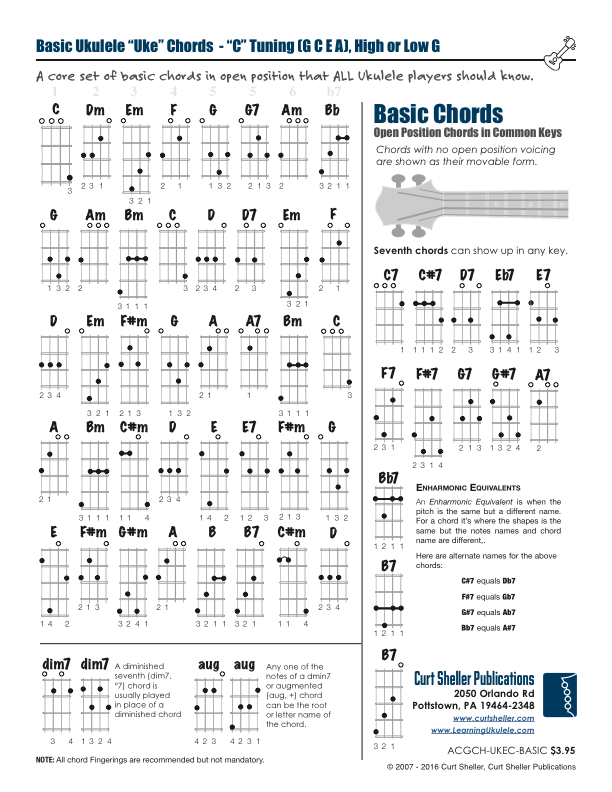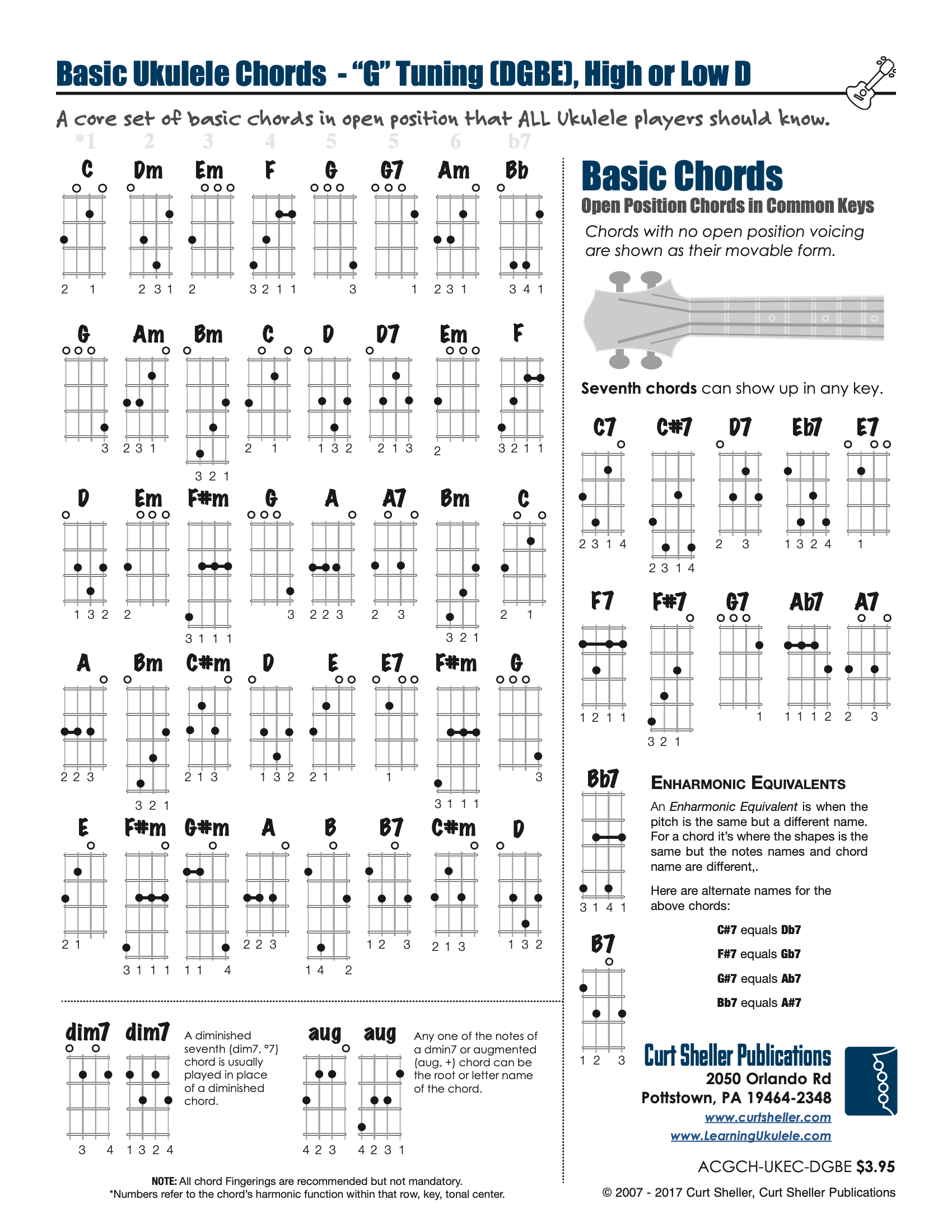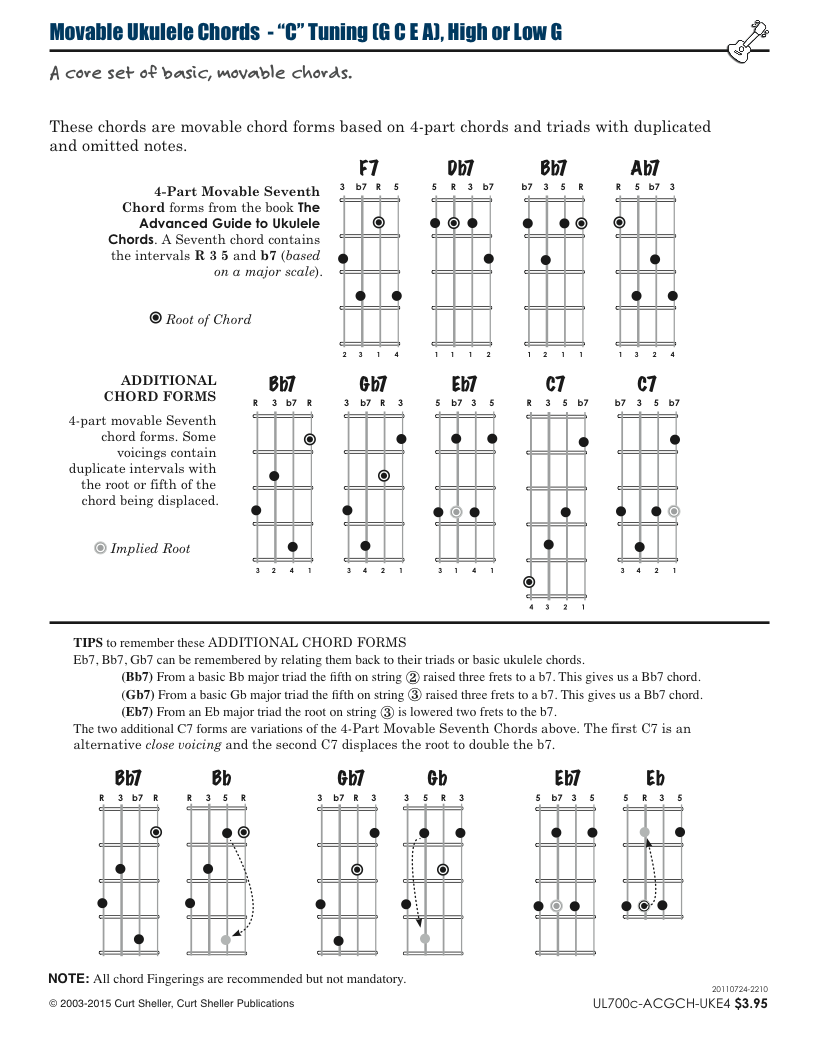Chords • Chords • Chords
It's ALL About Playing & Learning Chords
Chords & Chord Progressions — A Chord is a fundamental building block of music and is commonly used in various musical styles and genres. Chords provide harmony and support for melodies, creating a rich and textured sound. It's what we do the most off — All about the types of chords possible on ukulele. Explore tyle of chords, how to organize your chords, and more...



Chords – What You Do The Most of hellip;
Of the three core elements of music: Melody — Harmony — Rhythm. It's the harmony — the chords and chord progressions, a.k.a. songs, that you'll do the most of. So, whether you're playing covers or writing your own — you need to know your chords and how they works together.
Chords can not be named out of context. They can only be named in the context of a chord progression or chord sequence and then only when the chord's harmonic function within that progression can be determined.— Curt Sheller
That's the single most sensible statement about music that I've read in months, maybe years. Thanks, Curt.— John Kavanagh, The 4th Peg Parlor Room
What is a Chord?
A Chord is a harmonic combination of three or more notes played simultaneously.

A Chord is a fundamental building block of music and is commonly used in various musical styles and genres. Chords provide harmony and support for melodies, creating a rich and textured sound.
Chords are typically constructed by stacking notes on top of each other, based on specific intervals. The most common type of chord is the triad, which consists of three notes. Traditional triads are formed by stacking two intervals of a third (a distance of two whole steps or four half steps) on top of a root note. In music theory these chords built in thirds is called Tertiary Harmony .
Traditional three-note chords are called a triad. Two notes are an interval, or dyad. Chords with four notes are a tetrachord or 4-part chord; six notes are a hexachord, etc. These chords built in thirds (triads) are the the ONLY chords with traditional names: major, minor, diminished, and augmented. Chords beyond the triads - 4-part, 5-part, 6-part and, 7-part chords are still based on theses triads and their traditional names.
These traditional triads, built in thirds, are the only chords that have traditionally been named with a capital letter and chord type information. All traditional names are based on these four types: Major, Minor, Diminished, and Augmented. Each chord type has a distinctive sound and emotional quality. NOTE: there is NO
Dominantchord type — dominant is a harmonic function and NOT a chord name.
Every chord can be given a specific name based on the notes that constitute the chord and the distances or intervals between the notes. As well as a
Chord's Harmonic Functionwithin a specific tonality or chord progression. It's actually this harmonic function that determines the name of the chord.
This
Harmonic Functionis a critical part of a chord, and once and only once you determine the chord's, harmonic function can you successfully go about Naming Chords . A chord shape can have many possible names, but only one name at a time in the current harmonic context. Once the correct name is determined, you can then actually get the correct Chord Spelling — the actual note names of the individual notes of the chord.
(wikiwand)
• A Chord, in music, is any harmonic set of pitches/frequencies consisting of multiple notes (also called "pitches") that are heard as if sounding simultaneously. For many practical and theoretical purposes, arpeggios and broken chords (in which the notes of the chord are sounded one after the other, rather than simultaneously), or sequences of chord tones, may also be considered as chords in the right musical context.
Chords Built in Other Intervals
Quartal Chords built in Fourths?
Chords can be built using ANY interval. With chords built in thirds thirds having a traditional notation, Quartal chords are wide open the what you might run into. I (Curt), checked with ChatGPT to see what has been used. It came back with a bunch of crazy naming, none I would ever recommend. For years I would use
Qto indicate a chord built in fourths and the number of notes. Examples CQ3, would be a C root with three notes using fourths to build the chord.
An example of using fourths in songs is
(wikiwand)
McCoy Tyner on Miles Davis's Kind of Blue album and the song So What. On my Midnight at the Jazz Cafe the into to There Will Never Be Another You is in quartal chords built fourths.
Here's what ChatGPT said about my recommendation to use
Qas a notation device:
While CQ3 is not currently a standard notation, it has the potential to be a useful and clear way to notate quartal chords. Promoting its use in relevant musical contexts could help it gain recognition and acceptance.. Thanks to Chuck Anderson for what we came up with late last century.
Types of Chords
Organizing Your Chords • Part 1
You can organize your chords into one of these four categories: Open Position Chords, Movable Form Chords, 4-part
JazzChords, and Free-form Chords.

1) Open Position Chords • Your basic chords in the first four frets, including at least one open string. These are what most players learn first. There are, at most, 20 chords in this category to get you through the common chords for the basic keys (
C
,
G
,
D
,
A
,
E
,
F
, and
Bb
).
2) Basic Movable Form Chords • Your basic Open Position Chords, re-fingered and transposed up the fingerboard to different keys. This includes transposing the open strings as well. In C Tuning, the Bb major chord is based on the open position A major chord. This chord is typically the first movable form one learns that fits this category.
3)
Jazz” ChordsThese contemporary 4-part chords find their way into a wide variety of music. This is a massive category where you really start to learn how chord construction works and can create any — Yes — ANY chord you run across.
4) Free Form Chords • These are the chords that don't fit into one of the previous three chord categories or are a basic triad using only three strings. This is where you “REALLY”, and I mean really, need to know the ukulele fingerboard and the notes of the chord, and from a firm foundation, can create most of these chords on the fly.
And at the heart of an overwhelming number, pretty much ALL of the chords we play are: Triads .
Traditional and Contemporary Triads • These triads, built in thirds, are the foundation for all chords in the above categories. Triads are also great for when you are improvising. The “adjacent set of three strings” are how these can be learned. The Basic Open Position major and minor chords on the ukulele are triads, with one of their notes doubled.
Basic Open Position Chords for C Tuning Chord Chart
A handy-dandy reference chart of open position chords in the five common keys of
C
,
G
,
D
,
A
, and
E
. With seventh chords, diminished and augmented chords for every root.
- View the Basic Open Position Chords for C Tuning lesson.
A Ukulele Chord a Day
The Ukulele Chord a Day series of lessons started in 2013. Videos for each chord were added in 2020. And, in 2023 the chords common harmonic function information was added.
This is a great series for beginners to get started and actually any level can benefit from the added material and information on each chord.
- View the A Ukulele Chord a Day Lesson Series .
Movable Form Chords
After learning the
Basic Open Positionchords, these 20 plus ukulele chord lessons cover the open position forms and their movable forms. This allows you to play basic chords in ANY key.
Click on any chord above to go that specific lesson.
- View the Movable Form Chords Lesson Series https://learningukulele.com/lessons/code/UL200
Core Chords — The "Big Six"
a.k.a.,
Jazz Chords,Chords
These chords, often call
Jazz Chords,find their way into a wide range of traditional and contemporary music. They form the foundation for building those chords with the wacky names such as 13-9, #11, 9b5, etc.
The 4-part Seventh chord, often called the Dominant Seventh chord, can form the foundation for ALL your core contemporary, a.k.a., jazz chords. This series of lessons covers the big six that finds wide use in all forms of contemporary music. Then builds on your core chords with the rest of the 4-part chords.
- View the Core Chords — The
Big Six
lesson. These are your foundation for building any 4-part chard you'll come across.
The Dominant Seventh Chord
Just What Is A Dominent Seventh?
Not all seventh chords are actually dominant seventh chords. Learn when a Dominant Seventh chord is truly a dominant chord.
- View The Dominant Seventh Chord lesson.
Cool Chords Lesson Series
Here are a few of the chords that are part of the Cool Ukulele Chords Series of lessons.
Putting Chords Together
What is a Chord Progression?
Simply put, a chord progression is a sequence of chords. Songs are chord progressions with melodies and lyrics added.
A chord progression (or harmonic progression) is a series of musical chords, or chord changes that "aims for a definite goal" of establishing (or contradicting) a tonality founded on a key, root or tonic chord. In other words, the succession of root relationships. Chords and chord theory are generally known as harmony.
A chord progression can be thought of as a harmonic simultaneity succession: it offers an ongoing shift of level that is essential to the music of Europe (at least since 1600), Oceania and South/West Africa. A change of chord, or "chord change", generally occurs on an accented beat, so that chord progressions may contribute significantly to the rhythm, meter and musical form of a piece, delineating bars, phrases and sections.
- (wikiwand); Chord Progressions
- (wikiwand); List of Chord Progressions
Common Chord Progressions
Turns out there are a lot of common chord sequences that make learning a lot of songs easier. Checkout the LearningUkulele.com lessons below.
- Simple Progressions https://learningukulele.com/lessons/code/UL59e
- Three Chord Progressions https://learningukulele.com/lessons/code/UL59f
- Four Chord Pop Progressions https://learningukulele.com/lessons/code/UL59g
- Blues Progressions
- 50’s Chord Progressions https://learningukulele.com/lessons/code/UL59d
- Andalusian Chord Progression https://learningukulele.com/lessons/code/UL59a
- Mixolydian Progression ( I – bVII – IV )https://learningukulele.com/lessons/code/UL59j
- Backdoor Chord Progression https://learningukulele.com/lessons/code/UL59b
- Sears Roebuck* bridge —
I Got Rhythm
www.wikiwand.com/en/articles/Sears_Roebuck_bridge • II7 VI7 II7 V7 . Often each 7th chord is proceeded with what would be its II chord. Here is an examples in the Key of C: E7 A7 D7 G7 and with their II chords Bm7 E7 Em7 A7 Am7 D7 Dm7 G7 . Notice we are going right around the Cycle of 4ths. - Montgomery-Ward* bridge www.wikiwand.com/en/articles/Montgomery-Ward_bridge — The bridge of Satin Doll is a classic Montgomery-Ward bridge.https://learningukulele.com/songs/code/UL417
* Sears Roebuck & Montgomery Ward were super common catalog and retail companies in the USA that the old jazzers attached those names to these very common chord progressions that show up a lot. A shorthand way to call a tune.
So, Lets Get Started
Without knowing where you are musically I would simply recommend to head over the Songs section, pick a song and learn the chords.
Here are a few really simple chord progressions without a lot of chords that you might passively already know:
- This Train https://learningukulele.com/songs/code/UL516
- Red River Valley https://learningukulele.com/songs/code/UL514
- This Land Is Your Land https://learningukulele.com/songs/code/UL601
- Brown Eyed Girl https://learningukulele.com/songs/code/UL505
- You Send Me https://learningukulele.com/songs/code/UL580
Organizing-Your-Chords
Part II — Your Options
If you're going to learn more than one song, it's probably a good idea to organize and create a chord vocabulary for learning songs beyond that first song.
Organizing ukulele chords can be done in several ways to make them more accessible and easier to navigate. Here are a few methods you can use to organize ukulele chords:
- Pick any Song: Learn the chords used in that song. Repeat the proccess for the next song, the next song, the next song, …
- Alphabetically: Arrange the chords in alphabetical order. This method allows you to quickly find chords based on their names. This is basically a chord dictionary.
- Key-based: Group the chords based on their respective keys. For example, gather all the chords in the Key of C together, then group chords in the Key of G , and so on. This organization can help you understand the chord progressions within each key. This is a great way if you are learning the Ukulele using songs.
- Chord Types*: You can organize your chords into these four categories (see above): Open Position Chords , Movable Form Chords , 4-part
Jazz
Chords , and Free-form Chords . This aligns with the next possibility. - Music Genre: Organize chords based on the musical genre they are commonly used in. For example, group chords commonly used in folk music, Blues , pop music, country, or Jazz . This organization can help you explore different styles and find chords that suit your preferred genres/styles.
- Common Chord Progressions: Organize chords based on common chord progressions. Group chords that are frequently used together in specific progressions, like I-IV-V or II-V-I . This organization helps you understand and memorize common harmonic patterns. This is the harmonic content of songs. And, pretty much everyone getting into playing and learning ukulele want, to play songs.
- Personalized System: Create your own system of organizing chords based on your preferences and learning style. You can categorize them by chord types (major, minor), chord extensions (7th, 9th, 13th), or any other criteria that makes sense to you. However, their is not need to re-invent the wheel — unless your system is better than any existing system that has been developed i the last 300 years.
* Personally I (Curt) settled on organizing by Chord Types & Common Chord Progressions.
Basic Ukulele Chords Charts – C Tuning
for Right Handed Players
for Left Handed Players

Basic Open Positions Chords – C Tuning in the common keys of C, G, D, A, and E – with seventh chords in all keys. Includes diminished and augmented chords.
Download FREE
Chart
These charts are available in the LearningUkulele.com Books section of the site by clicking on the buttons below the charts.
The following two charts are for C Tuning and organized by the common chords that show up in common keys.
These charts are FREE
downloads and available in right hand and left hand versions.

Basic Open Positions Chords for Lefties – C Tuning in the common keys of C, G, D, A, and E – with seventh chords in all keys. Includes diminished and augmented chords.
Download FREE
Chart
Basic Ukulele Chords Charts – G Tuning
for Baritone Players
Core Seventh Chords – C Tuning

Basic Open Position `Ukulele Chord Chart — Baritone/G Tuning in the common keys of C, G, D, A, and E – with seventh chords in all keys. Includes diminished and augmented chords.
Download FREE
Chart
These charts are available in the LearningUkulele.com Books section of the site by clicking on the buttons below the charts.

Core Ukulele Chords—Sevenths • These chords are movable chord forms based on core 4-part seventh chords and triads with duplicated and/or omitted notes.
Download FREE
Chart
ALL Additional Reference Charts are Available on the LearningUkulele.com Books Page .
End of Lesson - Thanks, Hope You Enjoyed It!
Checkout the Lessons' section as the majority of lesson are regarding chords and chord progressions.
🚀 🚧 End of LearningUkulele.com Site Content 🚧 🌍



.jpg)